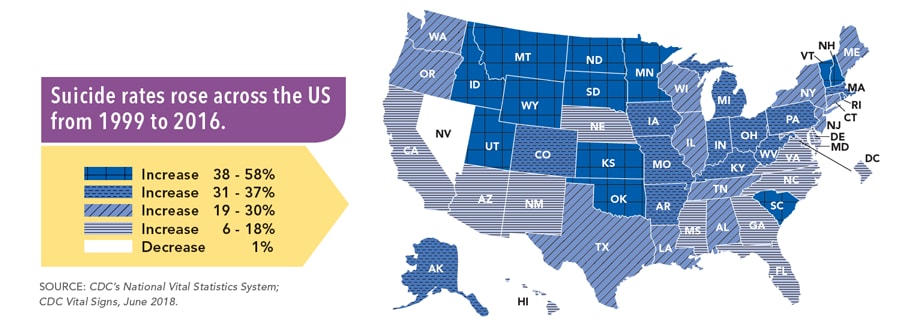The suicide rate in America is up by 18% since 2000. This is not merely a tragedy; it matters politically, too. The rise is largely among white, middle-aged, poorly educated men in areas that were left behind by booms and crushed by busts...
Nonetheless, beyond America’s gloomy trend is a more optimistic story: that at a global level, suicide is down by 29% since 2000 (see article). As a result, 2.8m lives have been saved in that time—three times as many as have been killed in battle. There is no one reason. It is happening at different rates among different groups in different places. But the decline is particularly notable among three sets of people.
The suicide rate among the US working age population increased 34 percent during 2000-2016. A new report published today in CDC’s Morbidity and Mortality Weekly Report (MMWR) examined lifetime occupations of 22,053 people aged 16-64 years old who died by suicide in the 17 states participating in the National Violent Death Reporting System (NVDRS) in 2012 and 2015.
In 2012 and 2015, suicide rates were highest among males in the Construction and Extraction occupational group (43.6 and 53.2 per 100,000 civilian noninstitutionalized working persons, respectively) and highest among females in the Arts, Design, Entertainment, Sports, and Media group (11.7 and 15.6 per 100,000, respectively).
From 2012 to 2015, suicide rates increased most for males in Arts, Design, Entertainment, Sports, and Media occupations (47 percent) and for females in Food Preparation and Serving Related occupations (54 percent).
“Increasing suicide rates in the U.S. are a concerning trend that represent a tragedy for families and communities and impact the American workforce,” said Deb Houry, M.D., M.P.H., director, CDC National Center for Injury Prevention and Control. “Knowing who is at greater risk for suicide can help save lives through focused prevention efforts.”
A June release from CDC:
Suicide is a leading cause of death in the US. Suicide rates increased in nearly every state from 1999 through 2016. Mental health conditions are often seen as the cause of suicide, but suicide is rarely caused by any single factor. In fact, many people who die by suicide are not known to have a diagnosed mental health condition at the time of death. Other problems often contribute to suicide, such as those related to relationships, substance use, physical health, and job, money, legal, or housing stress. Making sure government, public health, healthcare, employers, education, the media and community organizations are working together is important for preventing suicide. Public health departments can bring together these partners to focus on comprehensive state and community efforts with the greatest likelihood of preventing suicide.
